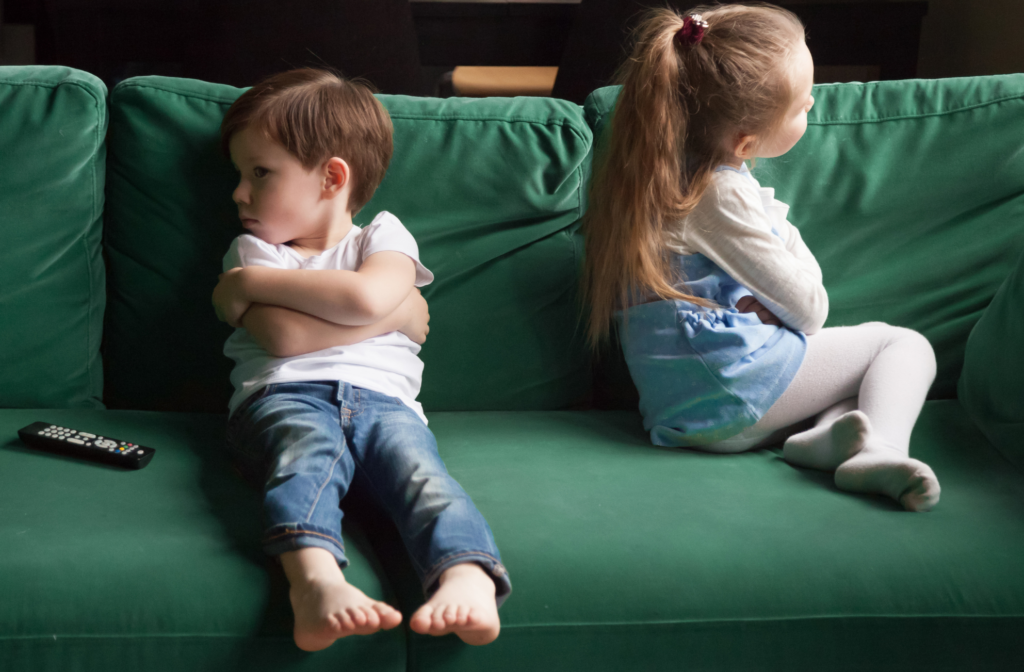Inside: What are the causes of sibling rivalry? Are sibling rivalries normal? What are examples of sibling rivalry behaviours? Three mistakes that parents make when managing siblings arguments and how do you deal with sibling rivalries.
What is sibling rivalry?
Sibling rivalry is the ongoing conflict between children in the same family. Siblings feel jealous and are constantly fighting and arguing with one another as they see each other as competitors.

What are the causes of sibling rivalry?
Children feel anxious when there is another child in the family. To them, the sibling is a competitor. Chances of survival are decreased when scarce resources have to be shared. In this case, the precious resources are your time and attention. It is very hard for children to share their parents.
In addition, children’s brains are not fully developed to rationalise concepts of sharing, empathy, emotional regulation. They are not able to verbalise their unmet needs of big feelings of jealousy, attention-seeking, power struggles etc. As a result, they express their feelings in other ways- name calling, tattling and bickering, verbal and physical fighting, voicing feelings of injustice and envy etc.
Since we cannot rush the brain to develop, your children now need your patience, reminders and coaching.
Are sibling rivalries normal?
It is completely normal for children and siblings to argue. When siblings see each other as competitors vying for limited resources like a parent’s love and attention, they will act out to feel seen and heard.
However, it doesn’t mean that we do not intervene to guide our children. 💡 If we look at it from a different perspective, these situations are actually great opportunities for us to teach many valuable skills in our home. These teaching moments can benefit our children when they are interacting and socializing with others be it in school or at other social situations.
How can we reduce it?
While it is almost impossible to completely eliminate sibling rivalry, you can definitely put some strategies in place to reduce the frequency of it as well as to handle it in a more peaceful and restful manner.
I highly recommend you download my Siblings Rivalry Guide where I share 7 strategies to navigate siblings conflict. In addition, I’ve also included a free activity printable “The Siblings Profile Activity” to promote sibling bonding.

Read all the way to the end to download this guide! 😉
3 mistakes that parents make when it comes to dealing with sibling rivalry
Mistake #1: Parents jump in too quickly to intervene
As parents, we often want to avoid conflict altogether and make sure that the kids don’t cry or throw tantrums. However, by doing that, we are robbing our kids of opportunities we want our children to learn how to work things out on their own and to come up with solutions to their problems. If we are to quick to intervene, children learn to rely on their parents instead of trying to manage their own conflicts.
So when do we intervene? One way is to think of a traffic light 🚦
GREEN LIGHT:
When kids are bickering, take a step back, pause and listen. There is no need to go between them.
AMBER LIGHT:
When situations heat up, intervene to provide guidance
RED LIGHT:
When there is verbal or physical aggression, separate the kids.

Give your kids space and time to sort out their conflicts. However, if safety is compromised (i.e. they are hurting each other), then please do not hesitate to step in.
If you are wondering what to say or do during these conflicts, I have a workshop where I share your exact roles during these arguments, and suggested scripts to help you turn these disputes into teachable moments for your kids.
Click here for more information about my siblings workshop.
Mistake #2: Parents force kids to share
Imagine yourself happily reading a novel and someone else comes to you, saying firmly, “I want to read this book now, pass it to me now! Sharing is caring.” How would you feel?
As parents, we hope for our children to look beyond themselves to care for others around them. And of course we hope for them to share their toys with their siblings! However, sharing is an act of generosity that does not come automatically. Young kids are developmentally not ready to share. It takes time for children to be truly altruistic and ready to relinquish something they value.
If we force kids to share, we are…
❌Teaching them to disregard their own wants and needs
❌Robbing them of opportunities to practise problem solving
❌Interrupting the child’s play
If kids are sharing on the parents’ demands, they might learn not to share when their parents are not around, that if they force someone to share, they will get what they want, and how it’s ok to give up and let people decide what they should do.
So what do we do if our kids refuse to share?
Firstly, validate emotions and show empathy. “It’s so hard to wait when you really want to play with that toy truck.”
Offer suggestions and encourage them to take turns. “He’s not done with the truck yet. What could we play with while waiting for your turn?” “Could you let your brother know when you’re all done?”
Affirm any positive behaviour shown. “You were angry when he snatched your toy away, but you had self-control not to push him.”

When your children are not sharing, they are not selfish, they are just not ready yet. To encourage children to share, let’s allow them to do so at their own pace.
Connect with them, teach them how to take turns, and celebrate it when they do well! 👶🏻👧🏻👦🏻
Mistake #3: Parents often compare their kids to siblings
It is so easy to turn to one sibling and utter these phrases: “Why can’t you be like…” or “Your sister is faster/stronger/more creative/etc” or “Look! Your brother is already done. Hurry up!”
When we compare our child and put labels on them (e.g. smarter, quicker, taller, artsy-er), we end up increasing the spirit of competitiveness between siblings. This includes when you’re speaking to other people about your children. Our little ones have sharper hearing that you know!
When we refer to one child as the “more creative one”, the other child begins to think “I guess I am not as creative”. When we unintentionally say, “She eats so much faster”, the other sibling begins to think that eating slowly is a ‘bad’ thing. Feelings of inferiority can creep in through these instances.
Therefore, by consciously making the effort to ditch comparisons and labels on our children, we are encouraging them to celebrate differences and uniqueness and to cheer each other on and support one another instead of competing against each other.
Summary
Learning to work well with others take time and children need opportunities to practise social skills. And there are plenty of them! Every single interaction between the siblings are teachable moments as they negotiate, communicate, problem solve and make compromises. We don’t want to rob them off these chances to learn valuable communication and social skills.
To recap, the 3 common mistakes to avoid:
Mistake #1: Parents jump in too quickly to intervene
Mistake #2: Parents force kids to share
Mistake #3: Parents are often comparing their children
Here’s your free Resource Guide to Sibling Rivalry

I share 7 tips to help you reduce sibling conflicts and manage them like a pro!
